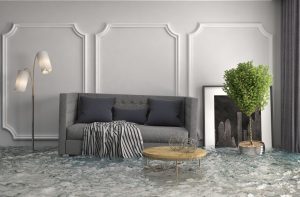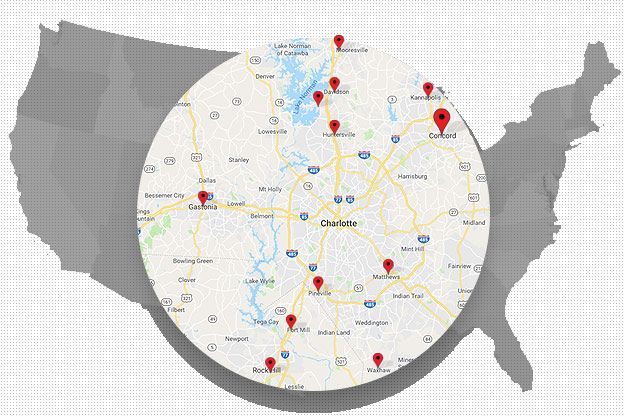What Is Involved in the Basement Waterproofing Process?

A finished basement is one of the ultimate homeowner goals, an excellent way to add home value and improve your family’s quality of life.
There are several good reasons to upgrade your basement, whether you want additional storage, an extra bedroom, or a man-cave to escape to for a couple of hours. But before you make the dream a reality, you’ll need to fix the one detail that plagues the majority of basements — moisture.
Basement waterproofing is crucial to keep water from destroying a living space and everything in it. If you’re considering upgrading your basement, read on as we break down the different ways you can approach the basement waterproofing process.
Interior Basement Waterproofing
Interior waterproofing options can range from the most simple and temporary to the most complex and effective.
Many fixes for minute moisture problems can involve basic DIY tactics like running a dehumidifier or filling holes. These are often the first lines of attack when you notice the initial signs of basement moisture.
Let’s look at two popular methods for protecting the inside of your basement.
Foundation Coatings
One of the easiest ways to keep basement moisture levels down is with waterproof paints and sealants. These thick, heavy-duty coatings go over unpainted masonry and concrete, filling tiny holes and cracks to make a waterproof seal.
It’s one of the cheapest methods, costing around $150 for materials and about $500-$1000 for professional work. This can easily be a DIY chore if you have a simple setup.
Unfortunately, while it may prevent slight water seepage, it doesn’t fix the root of the problem, and water will continue coming through the wall. Over time, it can break through the seal or cause further damage along the wall. If a contractor uses this method, it’s usually one part of a more permanent solution.
French Drains and Sump Pumps
One of the most effective waterproofing solutions is an interior french drain installed under the basement floor, right where it meets the wall.
A french drain is a perforated pipe that directs incoming water away from the basement to a sump pump. To install the system, it’s best to work with a professional basement waterproofing company.
The technician will break through the concrete floor to dig a trench about 10″ in deep along the perimeter of the basement. They install the line of piping and fill it back in with drainage gravel before recovering the basement floor.
The drain runs to a sump pump, an electrically powered pump that sits in a sump pit at the lowest point in the basement. Once the pit fills with water, the pump drains the water out.
The whole system lasts several years, though the sump pump might need replacement every 10-12 years, which will cost you roughly $1000. For a professional installation, the whole system can run between $3000-$4000.
An interior French drain is excellent at draining excess water, the kind that causes flooding. However, you may need to use it in tandem with an interior or exterior coating to prevent water vapor penetration.
Exterior Basement Waterproofing
Exterior waterproofing options include barriers and water flow redirection. With outdoor methods, you protect your entire foundation, not just the inside.
Soil Grading
An excellent waterproofing tactic is to reduce the need for it in the first place. If your property has the wrong grade, water may flow right up the foundation, increasing the amount of groundwater and hydrostatic pressure that can add to moisture levels.
A well-placed exterior French drain can manage areas where water collects, but you can also help matters with just a shovel. If you regrade around the outside of your house, building up walls with soil to create a slope away from the house, you’ll take care of many rainwater issues.
It’s just as important to clean your gutters each year and make sure the spouts are pointed away from the house. It’s a basic consideration, but it is critical if you want to prevent water from pooling around the foundation.
Exterior Wall Waterproofing
Sealing the exterior foundation wall is great for both keeping groundwater and water vapor from attacking your foundation.
A contractor will dig a trench around the outside of your house to expose the bare foundation. Then, they will coat the wall with a powerful polymer-based sealant, creating a waterproof membrane that can last several years. Beyond this, a dimple board is installed to deflect water from the wall.
With the trench dug out, the installer will run drain tile, a series of PVC pipes (like the French drain) that lead to a drainage system or sump pump. It’s then covered with gravel fill to relieve hydrostatic pressure that could build up against the basement wall. Finally, the loose backfill that was dug up is added back in.
The whole basement waterproofing process is labor-intensive and often requires special equipment. It is one of the most expensive routes. Still, it’s one of the best options for both dampness and water penetration.
DIY Water Management
Clean gutters and properly directed downspouts can be your best friends when you’re trying to keep water from getting near your foundation. But that’s not the only easy but effective way to make a difference.
Regrading can often be a simple task, as you only need about a 5-degree slope to manage rain runoff. Removing plants that are within a foot of your foundation can get rid of moisture traps as well.
Is Waterproofing Right for You?
Waterproofing your basement will give you a blank canvass to create a whole new home within a home. With the peace of mind that your basement is protected, you can confidently create a space to enjoy for years to come.
Are you ready for all of the benefits of basement waterproofing? Contact our experts at Sedona Waterproofing Solutions for a free quote.
Recent Posts
- How Crawl Space Encapsulation Benefits the Environment – An Expert Guide
- 6 Ways Professionals Keep Your Crawl Space in Top Shape
- Structural Repair Solutions for Crawl Spaces, Basements, and Foundations
- Essential Crawl Space Repair Tips Every Homeowner Should Know
- The Importance of Radon Mitigation: Ensuring a Safe Living Environment for Homeowners
Categories
- Basement Mold
- Basement Waterproof Foundation
- Basement Waterproofing
- Crawl Space Dehumidifier
- Crawl Space Encapsulation Cost
- Crawl Space Repair
- Crawl Space Waterproofing
- Encapsulation
- Foundation Repair
- Foundation Waterproofing
- French Drains
- Leaky Basement
- Mold Remediation
- Mold Removal
- Radon
- Slab Jacking
- Sump Pump
- Uncategorized
- Vapor Barrier
- Water Leak
- Waterproofing
- White Mold
Archives
- June 2024
- May 2024
- March 2024
- January 2024
- June 2023
- May 2023
- April 2023
- March 2023
- February 2023
- January 2023
- December 2022
- November 2022
- October 2022
- September 2022
- August 2022
- July 2022
- June 2022
- May 2022
- March 2022
- February 2022
- January 2022
- December 2021
- November 2021
- October 2021
- September 2021
- August 2021
- July 2021
- June 2021
- May 2021
- April 2021
- March 2021
- February 2021
- January 2021
- December 2020
- November 2020
- October 2020
- September 2020
- August 2020
- July 2020
- June 2020
- May 2020
- April 2020
- March 2020
- February 2020
- January 2020
- December 2019
- November 2019
- October 2019
- September 2019
- August 2019
- July 2019
- June 2019
- May 2019

